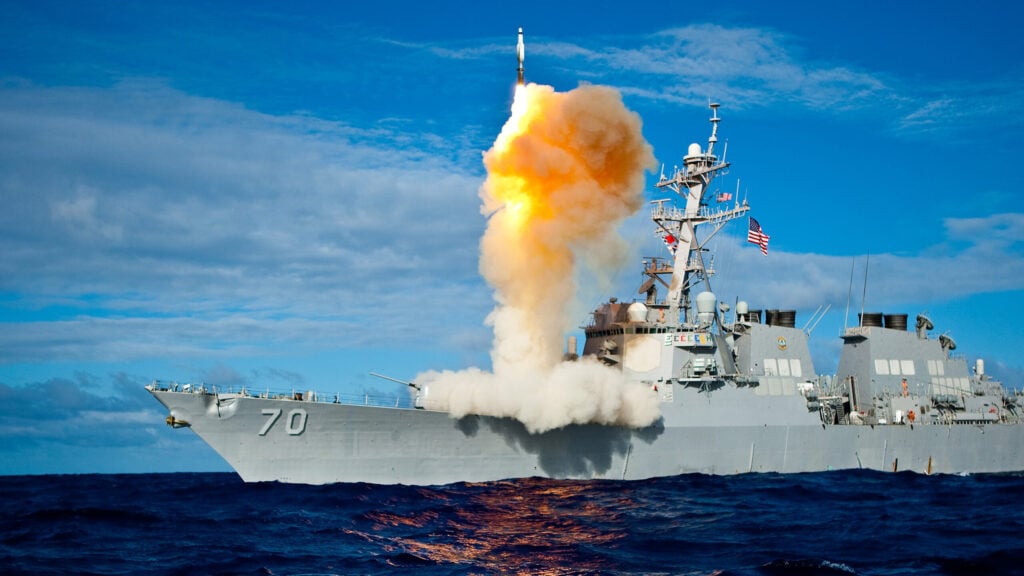USS Hopper launches a Standard Missile 3 Blk IA, successfully intercepting a sub-scale short range ballistic missile, launched from the Kauai Test Facility, Pacific Missile Range Facility, Barking Sans, Kauai. (Fred Baker / OSD Public Affairs)
WEST 2024 — After raising alarm bells to Capitol Hill near the start of the conflict in Ukraine, a top Marine Corps general here said he remains concerned about the service’s ability, or lack thereof, to maintain its munitions stockpiles while continuing to aid Kyiv, and now fend off Houthi rebel attacks in the Middle East.
Lt. Gen. Karsten Heckl, the service’s top requirements officer, referenced the Russian landing ship Cesar Kunikov, which Ukraine this week claimed to sink using several naval drones, as an example of how the Pentagon is not on the “right side” of the cost curve when it comes to defeating large swarms of unmanned vehicles.
“I know from the Marine Corps perspective, we’re working very hard to get on the right side of the cost curve,” he said. The Russian ship was sunk by “$60,000 worth of jet skis.”
The problem Heckl was alluding to is not a new one for the Pentagon, but it is becoming increasingly prominent in light of the two major conflicts in which the US is tangentially engaged — Ukraine against Russia, and Israel against Hamas.
That problem goes like this. The munitions, such as Standard Missile-6, that Navy ships often rely upon to defeat incoming threats have proven themselves highly reliable in taking out most weapons that could threaten a warship. But those weapons are also expensive — much more expensive than “jet skis” packed with explosives.
The question then becomes how long can the US afford to spend millions of dollars on missiles taking out inexpensive drones?
“How long can our magazines maintain this?” Heckl told reporters on the sidelines of the conference. “SM-6 … That’s a pretty exquisite piece of gear. Very, very effective. … How long can we sustain this? And remember, right now we’re just dealing with Houthis.”
What happens if there’s a “wider regional conflict and now we have other actors coming in with much more capable [weapons] than the Houthis?” he continued.
Liz Nashold, the deputy commander for Naval Information Forces, said during the panel that the cost issue is “a challenge” her command is actively working to overcome.
“We’re looking for anything that can deny, degrade, deceive, destroy from a non-kinetic effect perspective, so that we can save the ammunition and the ordinance that we have,” she said. “At this classification level, we do have those capabilities and we are working to improve [the tactics, techniques and procedures] based on lessons learned going on right now.”
Vice Adm. Brendan McLane, the surface warfare boss whose forces have been directly engaged in fending off Houthi attacks, took exception to the question of cost, arguing that the price tag on a missile pales in comparison to keeping the ship and its crew safe.
“I would also kind of quibble with the premise of the question going back to the Moskva. I’m sure if they would have been able to shoot down those incoming unmanned surface vessels, that trade-off from a cost perspective would have been worth it,” he said, referring to a Russian warship sunk by Ukrainian forces in April 2022.
He also suggested the advancement of directed energy weapons could help to mitigate the question of costs. But, as Breaking Defense reported in January, laser weapon development has not been nearly as rapid as some in the Pentagon had hoped.
Asked about his assessment of the Marine Corps’ stockpiles today compared to what he told lawmakers near the start of the Russia-Ukraine conflict, Heckl responded, “it’s the same.”
“Whether it’s munitions, whether it’s building SM-whatever, the real under pinning issue here is the anemic condition of [the] industrial base,” he said. “How did we win World War II? It was industry … How did we win the first Cold War against the Soviets? Industrial economic might. We spent the Soviets into the ground.”
“We will not have that luxury with [China],” he added.




















Discussion about this post